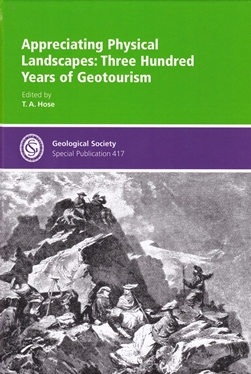
This is a history book, not a geological tourist guide. 'Geotourism' is the study of travel to enjoy and, importantly, to understand scenery. With its origins in the C17
th Grand Tour, geotourism was expanded by antiquarian's observations in the C18
th and further developed in the C19
th as the interest in geology blossomed. The Romantic movement saw wild landscapes used by the increasing urban population as a source of recreation. Modern geodiversity tourism is the legacy.
Based on an international conference of the History of Geology Group, an introductory paper sets the scene and defines this special interest form of travel with examples from around the world; including definitions of 'casual' and 'dedicated' recreational geologists. The remaining papers are case history studies.
In C18th Scotland Geology, tourism and landscape aesthetics all developed together, obtaining wider appeal with Cook's tours to the classic locations from Scott's novels and culminating in the modern Geopark. Waterfalls have a long history of aesthetic appreciation, but conflicts with navigation improvements or extraction of energy can diminish their cultural value. The Haarlem school of geomorphologically accurate landscape painters owes its origins to the coastal dune system of Holland. Similarly, von Guérard was a strong believer in painting geologically informed landscapes, which he did in Europe and Australia.
Other case histories encompass Norwegian and central European mountains, Alpine river gorges, Danube valley loess in Serbia and the first known scientific descriptions of travels in Southwest England. Three papers consider the roles of: natural science societies in the Welsh borders; early photography on Geologists' Association expeditions; and mapping in the depiction and understanding of the landscape of the Peak District.
A benefit of historical, informed accounts (as cited by several authors) is to provided data for modern studies. For example, climate change effects on glacial volume and length; information on now-flooded gorges from times before reliable maps; or the removal of speliothems from caves. This information may reside in other countries. The mining methods at the Carclaze tin mine in Cornwall are published in France, but not England, having been obtained on behalf of the French Government by 'spies' posing as geotourists in 1765.
Unfortunately, the book is let down by the poor reproduction of historic and modern photographs. They comprise a series of muddy, mid-tones and it would have been so easy to stretch the contrast and provide improved visibility for the reader.
Reviewed by Kevin Privett
APPRECIATING PHYSICAL LANDSCAPES: THREE HUNDRED YEARS OF GEOTOURISM, by HOSE TA (Ed): 2016 GSL Special publication #417 248pp hbk. W:www/geolsoc.org.uk/bookshop